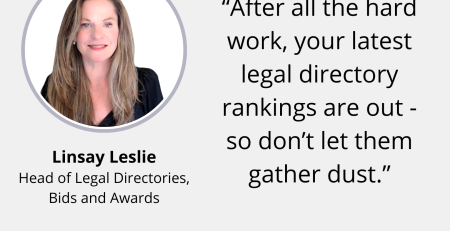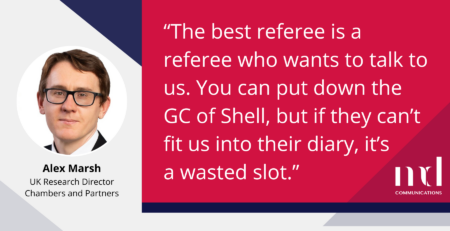Partner Linsay Leslie, Director of Content Anthony Notaras and Client Listening Director Julia Hepner discuss directories resolutions for 2024 and explore the opportunities present at each stage in the directories lifecycle.
On a rainy November day in Paris, MD Communications hosted a global cohort of legal directory enthusiasts to talk about the three Rs.
Gathered for the IBA annual conference, we brought together lawyers, senior marketing and business development professionals, and barristers from around the world in one, non-virtual room at the Saint James Club, a chateau dating back to 1829.
While the legal directories haven’t been around for quite that long, the mechanics of the rankings process don’t really change. However, we challenged our audience to reframe their approach for 2024.
Here are some of the takeaways from our directories challenger session.
Reframing
The time, cost and pressure associated with legal directory submissions is well documented, and the challenges versus benefits often debated. We encouraged our audience in Paris to reframe their thinking and take a glass half full approach. How do you do this?
Be strategic
We surveyed a large number of firms following the UK deadlines in 2023. 45% responded that they would like to do fewer submissions, while several firms highlighted the pressure on marketing and BD teams and the strain the directories put on their relationship with lawyers.
Firms often submit to multiple practice areas and multiple directories out of habit. Make sure that rankings and awards are a part of your overall reputation and BD strategy rather than a standalone project.
Incorporate directories into annual plans and have honest conversations to challenge the practices you submit for. Success fosters enthusiasm, so always prioritise your strongest submissions, no matter how niche they might be. Their success will incentivise others to take the process more seriously.
Take a year-round approach when it comes to matter capture
Few firms have nailed a system of routinely capturing matters throughout the year, for them to be easily dropped into the various templates in a calm way before the deadlines.
While Chambers and Legal 500 launch new practice areas every few years, the process and content rarely changes, nor do the mainstream categories that they cover.
Capturing matter highlight information throughout the year is the habit that will deliver the biggest savings at deadline time. Finding the method that works for your firm, or even just for your team is the biggest gift. The key – instil good habits and don’t over complicate the process.
Rankings
Understandably, firms focus hard on completing submissions and spreadsheets to meet the deadlines, after which the focus shifts towards the ranking results. But few firms grasp the opportunities at each stage in the directories lifecycle.
Increase the ROI on the work that goes into submissions by following some simple steps:
- Outstanding referee feedback comes from great relationships. Prioritise client and referral relationships all year round (not just in the run up to submitting the referee spreadsheet).
- Researchers don’t look at your submission in isolation. Pay attention to social media presence and your website. Your online presence along with referee and peer feedback must reflect what you say in your submission.
- Submissions are an annual snapshot of client relationships, team activity, volume of work and an honest review against peers for teams across the firm. Capitalise on and use the information gathered to increase your in-house knowledge, review strategy and client relationships, and spot any potential red flags.
Referees
The best written submission won’t get you far if clients either don’t respond in strong enough numbers or respond with negative feedback. And that does happen.
Client relationships are at the heart of the rankings. What are you hearing from clients throughout the year that is useful both for directory content and your list of referees? When rankings and editorial are released, are your client quotes aligned with your firm’s brand messaging? Do they match your perception of how your clients and the market view you?
Seize the opportunity to focus on your firm’s annual client listening and key client programmes.
A client that receives a quarterly check-in call from their relationship lawyers is more likely to respond positively when they’re asked to act as a referee at the end of the year. And that call will feel a lot less awkward. As with capturing your work highlights, this should be an ongoing process rather than an annual chore. And while the final rankings won’t be entirely in your control, at least the submission and referee process will be far more constructive, both externally and internally.
Need help with your directories? Contact our expert team.














